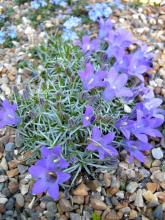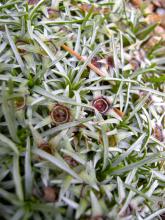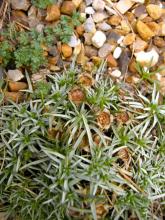As part of my new responsibilities as President, I'm reviewing everything that NARGS provides as a service to its members, and the Seed Exchange is certainly one of those services/benefits. Over the past few years the number of NARGS members who contribute seed to the SeedEx has declines, with the logical result that the quality and variety of seed available has diminished, leading to less interest in the SeedEx. This, of course, means that one of the leading benefits of NARGS membership is losing a lot of its attractiveness. And, of course, we want to reverse that process, and make the SeedEx what it was in the past, and (we believe) what it can be in the future.
So, what I'd like to ask those of you who are taking the time to read this, is:
1. If you DO contribute seed to the SeedEx, can you tell us why you do? Editorialize a bit, and share with us what the process of collecting, cleaning and packaging seed for the SeedEx really entails in time and effort. Thanks in advance.
2. If you DON'T contribute, could you tell us why you don't. Obviously a lot of our members don't contribute, and some of them have exceptionally fine gardens with a large variety of interesting and desirable plants.
I look forward to your responses, and feel free to add anything of relevance to the broad issue of seeds, germination, selection and Seed Exchanges of other organizations.
Comments
Re: The NARGS Seed Exchange (SeedEx)
The fabulous seed list was the original reason I joined NARGS! Even before I became much interested in alpines, I was attracted by the amazing selection of seeds for border plants and for every other sort of environment that one could duplicate in the garden. Many of my favourite plants, through time, have come from the generosity of people contributing seeds to the NARGS seed exchange. Growing from seed, and having access to a such a broad list, allows one to find interesting species that may never make it into main-stream commercial distribution in this area (which I gather from various forums, seems to be much less limited than in many other broad swathes through the continent). I doubt that people realize what an incredible bargain it is to be able to order seed from the exchange (even considering membership cost)!
I have been contributing seed to the exchange for a while now, since the time when it eventually dawned on me that maybe I too had some plants that others would be interested in growing! While I still do a few personal seed exchanges when asked, my preference is the seedex. Why? Well, I suppose to repay in part the personal benefits I have got from the seedex, and also to do my part to see that the seedex remains an opportunity for others too. I currently participate (donate seeds, buy seeds) in both the NARGS and SRGC seedexes.
More on seed-collecting to follow....
Re: The NARGS Seed Exchange (SeedEx)
Hi Peter,
My mentor in Rock gardening (who introduced me to ARGS and convinced me to join) was Ruth Tindale, sadly missed but an inspiration to many "new" rock gardeners. She was the first person to encourage me to grow bulbs and other rock plants from seed as I'd never considered it before! (I was only 25 at the time and thought everyone just bought new plants when they wanted them)
She was a donor to the Seedexes and highlighted the advantages of being a donor - especially for us overseas - with having priority when having your seed request filled as well as being entitled to extra packets.
The Seedex is a huge drawcard for us in Australia as we can't regularly get to meetings or Conferences or outings and the NARGS Seedex has a great selection, especially of plants native to North America. The labelling system is also an advantage with our Customs Inspection Service as they sometimes don't like having to look up numbers in a separate booklet! (A few years ago the Sydney office decided no seed would be allowed in if they were only numbered as they "didn't have the time" to check them against the names in the Seedlist - all the unlabelled seeds were destroyed!)
Seed collecting for us starts as soon as we've sent off the seed request as that's in our summer and many seed are already ripening in December and into January and so on. This year unfortunately we've had a disaster due to a mouse plague and some seed packets were emptied by the little rodents! They seemed to especially like Monsonia emarginata! I'm hopeful of having enough to send in by October as some of the early spring flowerers may be ready by then.
Sowing the seed we get happens a bit sporadically depending on the weather. It's generally too hot to sow anything till April in our area;if there's been no autumn rain there's no point in sowing as we can't keep all the seed trays watered properly. Unfortunately that sometimes means cold nights sitting outdoors sowing seed by the porchlight as the days draw in! Our winters are cold enough but not too severe and that seems to help some things germinate, especially bulbs - Calochortus are a favourite and most of the ones in the garden have come through the Seedexes. The fact that some seed is mislabelled is an annoyance but doesn't stop me from "ordering" some of the rare stuff - but if I know who the donor is (another advantage of the NARGS Seedex) I'm more confident of it being true.
cheers
fermi
Re: The NARGS Seed Exchange (SeedEx)
One of my favourite alpine plants is Edraianthus pumilio (in this lovely silver leaved form owerinianus). I almost missed catching the seed!! So advice for seed collectors - get out in the garden regularly to see what's ripening!
In flower; seed capsules maturing; seed capsules open, just like miniature bird's nests.
Re: The NARGS Seed Exchange (SeedEx)
Tim:
Great seed pictures. It would be nice to see more like that on the forum for other species.
We grow lots of Edraianthus pumilio but never get seed. The flowers last for a week or so but before they set seed they get cleaned out by slugs and/or birds. Depending on where you garden it is not always easy to collect seed from the garden. I collect most of my garden seed in the Alpine Shed which is much less prone to predation.
Re: The NARGS Seed Exchange (SeedEx)
Last year and this year, I have sent seeds in to the exchange.
But since I am just starting with alpines---I do not have much to offer.
I sent mostly seeds of dwarf annuals and biennials which are suitable as fillers in a rock garden.
As the alpines increase in my garden ,then I will be able to contribute more interesting plants.
On average it takes me about one day to prepare a set of seed envelopes to send.
Re: The NARGS Seed Exchange (SeedEx)
I feel ghastly ( really! ) that I didn't get seeds into the exchange for this year, I had collected several types but most of them were from late blooming plants and it turned out too late to get them into the exchange on time. I thought of mailing the package via the Canada Post "almost overnight" option, but realized that even then, when the envelope reached the border for inspection, and then sent on, chances of it arriving in a timely manner were small. I was so disgusted! In 2012 I'll have more plants of the early blooming variety ( I hope! ) and will be able to collect much earlier. My thanks to all of you who work so hard to organize the SeedEx, I can only imagine how much time and effort it takes.
Faith
Re: The NARGS Seed Exchange (SeedEx)
Faith - I wouldn't feel like that! It is the thought that counts. Despite my best intentions I didn't get seed cleaned in time, though I used to send seed regularly in the past. Like you I shall try better next year! The best encouragement is if you are keen on sowing seed yourself because there is always some left over for the exchange.
Re: The NARGS Seed Exchange (SeedEx)
I send seed every year to the NARGS exchange. Most of it wild collected or from high desert natives, I grow in my Garden. This is my way of connecting to other Rock Gardening enthusiasts and a way of promoting the use of little known Western American Flora.
It dose take time to clean seed there is no doubt. I feel however, that this is my way of contributing to the society in a small way.




Peter - I very strongly support the seed exchanges of the AGS and NARGS because they are really at the heart of our gardening. Over the years I have grown some wonderful plants from them, and the criticism often expressed, that seed is misnamed, has only been a minor problem in my experience. The wealth of plants available from the seed exchanges is quite extraordinary even for those of us who search out seed from many other sources too.
I have just started collecting seed and do nothing more than putting whole seedheads and stalks in paper bags and keeping them in a cool dry place. This way even green seed capsules can dry slowly and mature. Cleaning seed does take quite a time in some cases, but if you work through them steadily in the autumn (reasonably in advance of the seed exchange deadlines) it's not too onerous and I have always found it fascinating to see close up how seed is packaged by plants. A good range of sieves, a small brush, tweezers to remove larger debris and so forth, make the job a lot easier. Also a good light and spacious place to work - the kitchen table is ideal if you have an understanding spouse! I grow a very wide range of plants so collect a broad variety of plants, not just alpines. I also try to keep an eye on any particularly unusual species that may be setting good seed one year but not another. The old adage of sharing special plants with others rings true as conditions vary in different gardens.
I would urge anyone who has not contributed to the exchanges to get involved; it really adds so much to your gardening. (PS: I'm not sure what proportion of NARGS members donate seed, but for the AGS it is about 10%, so the desire to stimulate the exchanges is quite important).